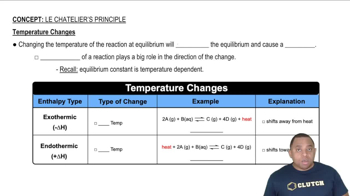The accompanying diagram shows how entropy varies with temperature for a substance that is a gas at the highest temperature shown. (c) If this substance is a perfect crystal at T = 0 K, what is the value of S at this temperature?
Methanol (CH3OH) can be made by the controlled oxidation of methane: CH4(g) + 1/2 O2(g) → CH3OH(g) (c) Calculate ΔG° at 298 K. Under standard conditions, is the reaction spontaneous at this temperature? (d) Is there a temperature at which the reaction would be at equilibrium under standard conditions and that is low enough so that the compounds involved are likely to be stable?
 Verified step by step guidance
Verified step by step guidanceKey Concepts
Gibbs Free Energy (ΔG)

Standard Conditions

Equilibrium and Temperature

Isomers are molecules that have the same chemical formula but different arrangements of atoms, as shown here for two isomers of pentane, C5H12.
(a) Do you expect a significant difference in the enthalpy of combustion of the two isomers? Explain.
Isomers are molecules that have the same chemical formula but different arrangements of atoms, as shown here for two isomers of pentane, C5H12.
(b) Which isomer do you expect to have the higher standard molar entropy? Explain.
The accompanying diagram shows how ΔH (red line) and TΔS (blue line) change with temperature for a hypothetical reaction.
(b) In what temperature range is this reaction spontaneous?
Consider a reaction A2(𝑔) + B2(𝑔) ⇌ 2 AB(𝑔), atoms of A shown in red in the diagram and atoms of B shown in blue. (a) If 𝐾𝑐 = 1, which box represents the system at equilibrium?
